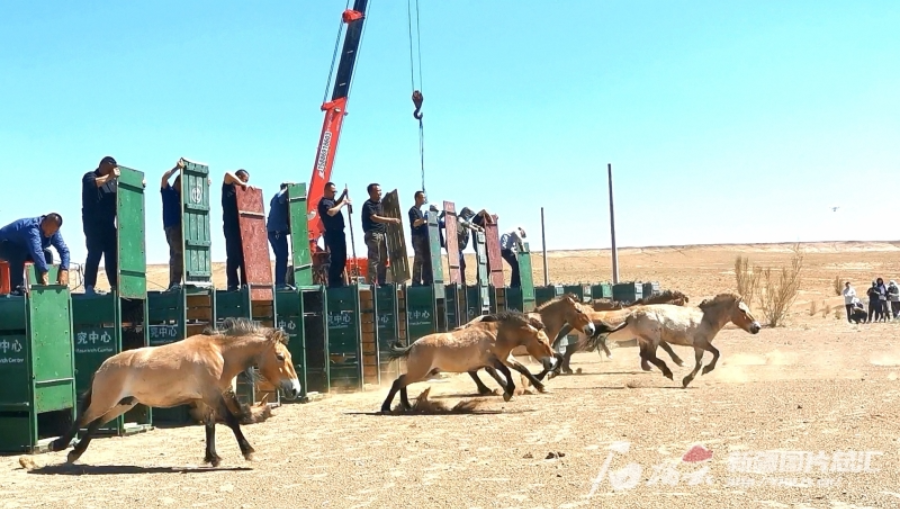Shiliuyun-Xinjiang Daily (Reporter Cao Hua) news: On the morning of May 9, 2024, after a two-year hiatus, Xinjiang once again initiated the work of releasing Przewalski's horses into the wild. A total of 18 carefully selected Przewalski's horses were released to the wilderness in Kalamaili Nature Reserve in Xinjiang. This is the 18th batch of Przewalski's horses released into the wild in Xinjiang, bringing the total number of these horses released in the region to 146.

Photo shows Przewalski's horses gallop towards the wilderness in northwest China’s Xinjiang Uygur Autonomous Region. (Photo by Shiliuyun-Xinjiang Daily/ Cao Hua)
That morning, the 18 wild horses were divided into two groups and transported from the Xinjiang Wild Horse Breeding and Research Center in Changji Hui Autonomous Prefecture to Kalamaili Nature Reserve, nearly 200 kilometers away. At 15:50 p.m., once everything was ready, the command was given, and as the horse boxes' doors were opened, the 18 horses dashed out like arrows shot from a bow. Going from the confines of the horse boxes to the vast expanse of the wilderness, the horses seemed initially disoriented. After running a few steps, they paused to nervously survey the unfamiliar surroundings and eagerly sought out their companions.
In order to calm the horses, the staff had scattered alfalfa around the area in advance, as it is their favorite food. Soon, the horses began to calm down, slowly gathering together, observing their surroundings while eating the alfalfa. After a brief period of adjustment, they started to move towards the depths of the prairie, heading towards their new home.

Photo shows Przewalski's horses released back into the wild leisurely take a stroll in their new home in northwest China’s Xinjiang Uygur Autonomous Region. (Photo by Shiliuyun-Xinjiang Daily/ Cao Hua)
"Among the 18 horses, there are seven stallions and 11 mares. The selection was mainly based on pedigree relationships, age structure, sex ratio, and health conditions," said Yang Jianming, director of the Xinjiang Wild Horse Breeding and Research Center. He added that the center would subsequently equip the horses with satellite tracking collars to monitor their migration and life in the new environment, recording scientific data for future expansion work of the release into the wild.
"Currently, there are 15 Przewalski's horses living around the management and protection station, including two foals born this year. With the arrival of the new horses, we will strengthen patrols and keep detailed records to help them quickly adapt to their new life," said Baketebieke Baikan, the head of the management and protection station.
The Przewalski's horse is believed to be the only wild horse species in existence today. It is listed as endangered by the International Union for Conservation of Nature Red List of Threatened Species and is under first-class national protection. Since 1985, China has been reintroducing these horses from international sources, starting with just 24 individuals. In 1986, the Xinjiang Wild Horse Breeding and Research Center was established to initiate the Return of the Wild Horses project. The aim is to expand the population of Przewalski's horses and carry out field reintroductions, ultimately leading to the natural proliferation of their wild populations.
"After more than thirty years of breeding research, by the end of 2023, the Przewalski's horse in Xinjiang has reached 534 individuals, making it the largest breeding base for these horses in the world," said Yang Jianming. In the first half of this year, the Xinjiang Wild Horse Breeding and Research Center initiated a DNA molecular-level testing project for Przewalski's horses, which will allow for more precise grouping of the animals. In the second half of the year, efforts will be made to start an artificial insemination project. By collaborating with domestic and international research institutions, the center aims to address the issue of genetic degeneration caused by inbreeding among Przewalski's horses and promote continuous growth in both population size and individual quality.
(A written permission shall be obtained for reprinting, excerpting, copying and mirroring of the contents published on this website. Unauthorized aforementioned act shall be deemed an infringement, of which the actor shall be held accountable under the law.)









